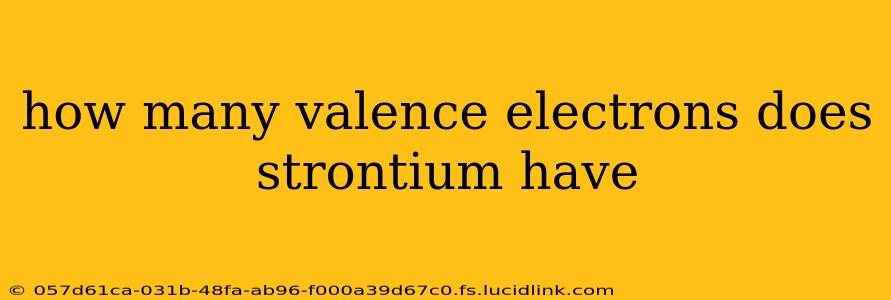Strontium (Sr), a soft, silvery-white alkaline earth metal, plays a fascinating role in various applications, from fireworks to specialized medical treatments. Understanding its electron configuration is key to grasping its chemical behavior and reactivity. So, how many valence electrons does strontium possess? The answer is two.
Let's delve deeper into why this is the case and explore some related concepts.
Understanding Valence Electrons
Valence electrons are the electrons located in the outermost shell (energy level) of an atom. These electrons are the ones involved in chemical bonding and determine an element's reactivity. The number of valence electrons dictates how an atom will interact with other atoms to form molecules and compounds. For example, elements with a full outer shell (eight electrons, except for helium with two) are generally unreactive, while those with fewer electrons in their outer shell tend to be more reactive.
Strontium's Electron Configuration
To determine strontium's valence electrons, we need to examine its electron configuration. Strontium has an atomic number of 38, meaning it has 38 electrons. Its electron configuration is [Kr]5s². The notation [Kr] represents the electron configuration of krypton (a noble gas), which is a stable, filled electron shell. The remaining two electrons are in the 5s subshell.
Because the outermost shell (the 5s subshell) contains two electrons, strontium has two valence electrons.
Why Does the Number of Valence Electrons Matter?
The number of valence electrons directly impacts an element's chemical properties:
-
Reactivity: Elements with one or two valence electrons readily lose those electrons to achieve a stable electron configuration, forming positively charged ions (cations). Strontium's two valence electrons make it highly reactive, readily losing them to form Sr²⁺ ions.
-
Bonding: The tendency to lose or gain electrons drives the formation of chemical bonds. Strontium, with its two valence electrons, typically forms ionic bonds with nonmetals, such as oxygen (forming strontium oxide, SrO), and chlorine (forming strontium chloride, SrCl₂).
What are some common Strontium Compounds?
Strontium's reactivity and its two valence electrons lead to the formation of various compounds, some of the most notable include:
- Strontium Oxide (SrO): Used in the production of glass and ceramics.
- Strontium Carbonate (SrCO₃): A component in some fireworks, providing a bright red color.
- Strontium Sulfate (SrSO₄): Found naturally in the mineral celestite.
What are the Properties of Strontium?
- Soft and Silvery-White: Strontium is a soft metal, easily cut with a knife.
- Reactive: It readily reacts with air and water.
- Alkaline Earth Metal: Belongs to Group 2 of the periodic table.
- Radioactive Isotopes: While most strontium is stable, some radioactive isotopes exist, notably Strontium-90, a byproduct of nuclear fission.
This comprehensive overview clarifies strontium's valence electron count and its importance in determining its chemical behavior and uses. Understanding valence electrons provides a foundational understanding of how elements interact and form the compounds that make up our world.
